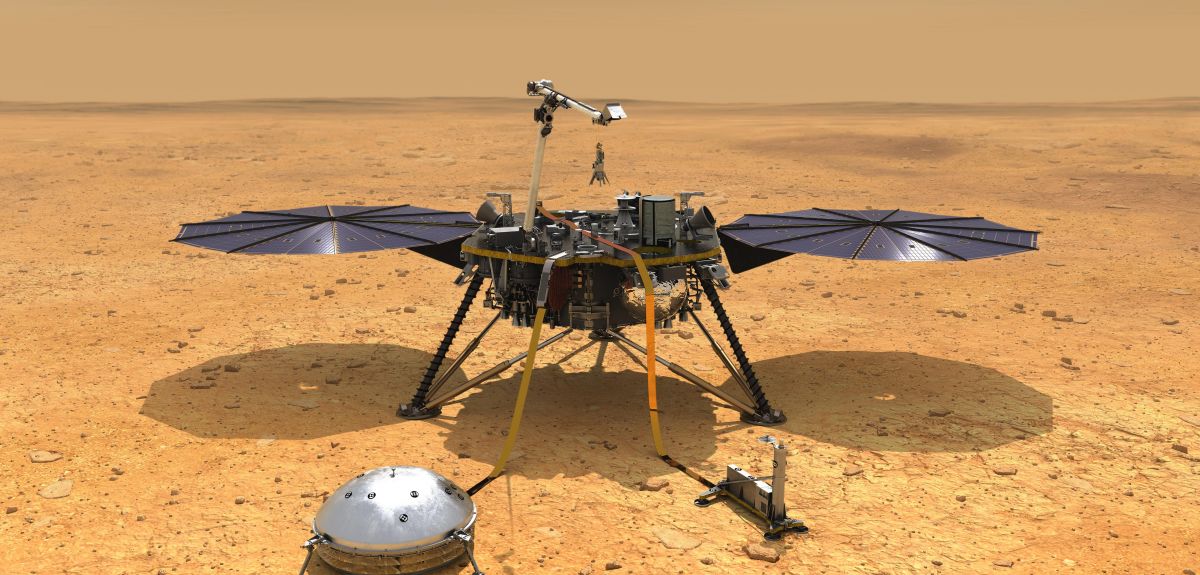
Image credit: NASA/JPL-Caltech
Marsquakes mission successfully lands on Red Planet
A mission to Mars which carries instruments co-designed by Oxford scientists, has successfully landed and will soon begin the first study of the heart of the planet.
The NASA InSight mission landed shortly after 19:50 GMT on Monday, 26 November.
InSight will study the inside of Mars to learn how planets, moons and meteorites with rocky surfaces, including the Earth and its Moon, formed. The lander’s instruments include a seismometer to detect 'Marsquakes' and a probe to monitor the flow of heat beneath the surface of the planet.
Scientists from Oxford's Department of Physics have been key to supporting one of the main instruments onboard: the short period Seismometer (SEIS-SP). This will be placed on the surface of Mars to detect seismic waves from Marsquakes and meteorite impacts.
The SP seismometer development was led by Professor Tom Pike from Imperial College London. The team led by Dr Simon Calcutt at the Department of Physics, University of Oxford, were responsible for packaging the sensor 'chips' from Imperial College, integrating them with control electronics, ensuring that they will survive in the space and Martian environment and testing the sensor performance. A team at the Rutherford Appleton Laboratory worked closely with Oxford in the electronics development and space qualification.
Dr Neil Bowles, from the University of Oxford's Department of Physics, said: 'The InSight SEIS-SP seismometer is one of the most sensitive and challenging instruments we have worked on for spaceflight in Oxford. After launch in May and successful instrument checks during the cruise to Mars, the team are absolutely delighted to witness the landing. We’ve shown that a traditionally delicate scientific instrument is capable of being launched on a rocket and the next challenge is to see how it behaves on the surface of the planet.
'With our partners at Imperial College London, STFC RAL Space and the UK Space Agency, getting the SEIS-SP seismometer assembled and qualified for flight has been a significant effort. After nearly a decade of preparation, building and testing we are incredibly excited that the science can now start.'
The instrument team will be joined by UK seismologists from Bristol, led by Dr Nick Teanby, Imperial, led by Professor Gareth Collins, and Oxford led by Dr Neil Bowles, to analyse the data from all of the mission’s instruments.
Anna Horleston, a researcher at Bristol University, said: 'I've studied seismic data from all over the world but to get the chance to study data from Mars is just something else. To finally see it arrive and to get to test out our techniques on real Martian seismic data is so exciting.'
The mission, which took off from California in May this year, will conduct six science investigations on and below the surface of Mars to uncover the evolutionary history that shaped all of the rocky planets in the inner solar system.
The UK instrument will work together with seismometers from France, as well as major contributions from Switzerland, Germany and the US. Other instruments on board include RISE, a precision radio tracking of the lander that can determine the direction and motion of the rotation of Mars and the HP3 (Heat Flow and Physical Properties Probe) which will study heat flow by embedding a temperature sensor under the surface of Mars.
The InSight Mission is led by Principal Investigator Bruce Banerdt at NASA's Jet Propulsion Laboratory, the SEIS instrument is led by Philippe Lognonné at the Institut de Physique du Globe (IPGP) Paris, France
InSight hopes to give answers to exciting scientific questions:
- Is Mars seismically active?
- What is Mars’ internal structure and how was the planet formed?
- Why is Mars smaller and with a lower density than Earth and Venus?
Mars’ size and density suggests that formation and evolution was somehow different to Earth’s or some process in the early Solar System prevented Mars from growing bigger. Answering these questions and comparing Mars, Earth and Venus allows scientists to test formation theories of planets and solar systems from our own to those around other stars.
InSight will be the first mission to place a seismometer directly on the surface Mars. The level of seismicity will be important for understanding Mars’ current state, i.e. how dead is it really?
InSight will answer the engineering challenge of getting super-sensitive instrumentation on to the surface of another planet.
 New study estimates NHS England spends 3% of its primary and secondary care budget on the health impacts of temperature
New study estimates NHS England spends 3% of its primary and secondary care budget on the health impacts of temperature
 International collaboration launches largest-ever therapeutics trial for patients hospitalised with dengue
International collaboration launches largest-ever therapeutics trial for patients hospitalised with dengue
 Oxford-built multi-agent assistant for cancer care to be piloted in collaboration with Microsoft
Oxford-built multi-agent assistant for cancer care to be piloted in collaboration with Microsoft
 World's first Phase II Nipah virus vaccine trial launch
World's first Phase II Nipah virus vaccine trial launch